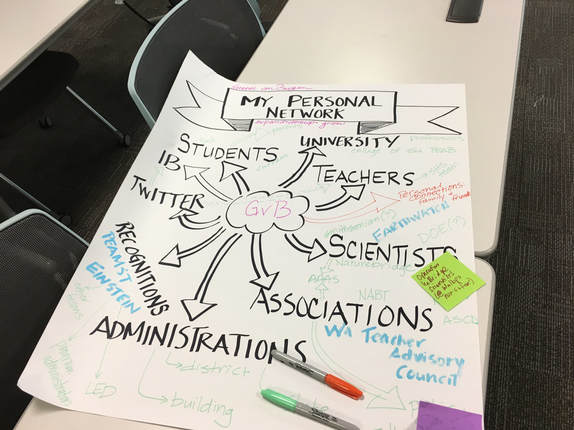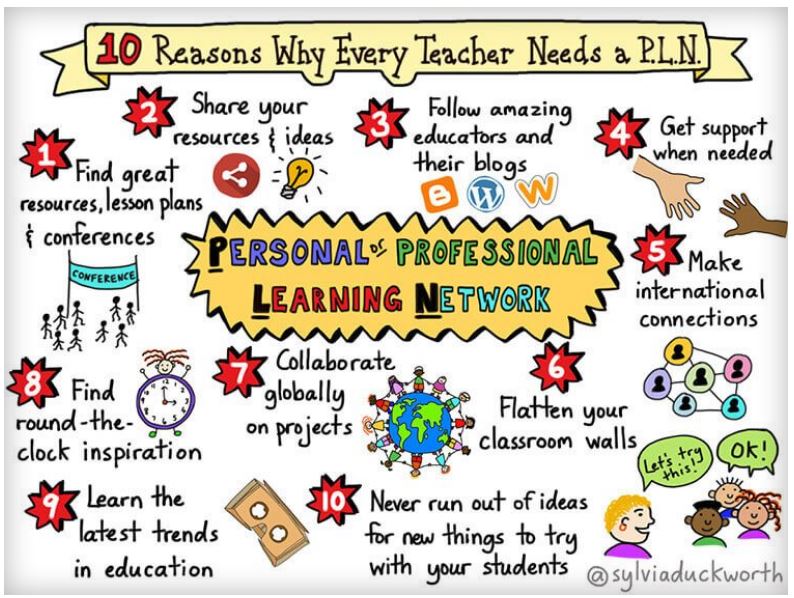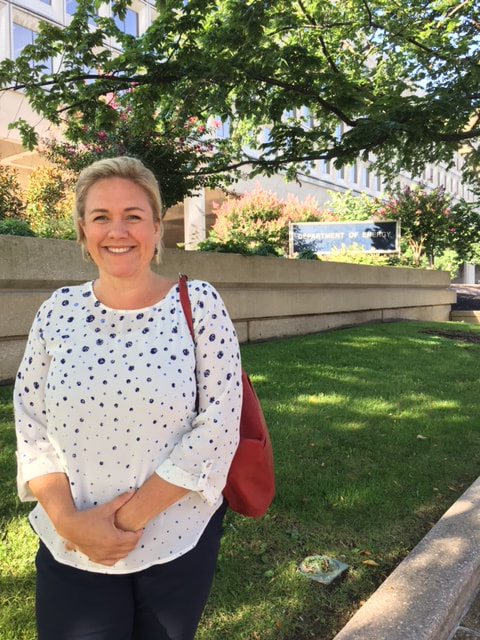|
The Einstein Fellows meet once a month for a full day professional development session. Our September gathering focused on recognizing and growing our professional networks. We drafted maps of our networks and then added comments and suggestions on the each others work. Many of the Fellows have no intention of returning to classroom teaching after the fellowship year, so I can see the value of networking; making and maintaining connections that might lead to a new employment opportunity. However, I plan on returning to classroom teaching next school year. As a result, I began to wonder about how my personal network matters as an educational professional and for the benefit of student learning. Not surprisingly, the internet provides a lovely visual graphic outlining the benefit of a network for teachers: Given the reason that many teachers leave careers in education is because they do not feel supported or respected as a professional (see my Keep Our Teachers post), I think teacher-to-teacher networks offer a glimmer of promise. Teachers who find ways to connect, commiserate and share experiences can support each other through the challenges of careers in teaching. This is #4 in the graphic above; get support when needed. At Skyline, we have Critical Friends Groups (CFG) which serve this function. While membership in a CFG might not benefit every teacher all the time, I have found that the groups I have been a member of and/or coached in the past have been effective sounding boards for the joys and frustrations of working in schools.
You'll see I've included Twitter on my personal network map. Sounds crazy, right? But actually, it's through Twitter that I've been able to make connections an find inspiration that directly impact my students and my instruction. Using #ibbio I've been able to find great resources (#1), share my resources and ideas (#2), follow amazing educators (#3) and make international connections (#5). For a long time I was the only person in my school district to be teaching IB Biology (that has since changed), so connecting with other IB Biology teachers through Twitter was a way for me to collaborate. I encourage others to be willing to support other teachers by virtually sharing materials or asking for assistance. You'll find me at @vb_ibbio. Beyond Twitter, I am building my virtual network by creating my LinkedIn page. Through LinkedIn I hope to be able to maintain connections with my former students and build connections with scientists willing to engage in secondary STEM education. As one of the other fellows stated at our professional development gathering, "networking" kind of has a negative connotation to it, as if one person is using another for an individual benefit. "What can this person do for me?" "How can I connect to so-and-so for my own better good?" Yuck. I feel uncomfortable with this intention behind networking. Perhaps because I am confident that my future will see me back in the classroom I know and love, I can view networking a little differently. Those in my network are not my personal stepping stones. I am not using others to get myself further along a path, I am building my network so that everyone in it can "go far with others". |
Archives
July 2018
|
I give many of my IB Biology resources away, for the benefit of students and teachers around the world.
If you've found the materials helpful, please consider making a contribution of any amount
to this Earthwatch Expedition Fund.
Did I forget something? Know of a mistake? Have a suggestion? Let me know by emailing me here.
Before using any of the files available on this site,
please familiarize yourself with the Creative Commons Attribution License.
It prohibits the use of any material on this site for commercial purposes of any kind.
If you've found the materials helpful, please consider making a contribution of any amount
to this Earthwatch Expedition Fund.
Did I forget something? Know of a mistake? Have a suggestion? Let me know by emailing me here.
Before using any of the files available on this site,
please familiarize yourself with the Creative Commons Attribution License.
It prohibits the use of any material on this site for commercial purposes of any kind.



